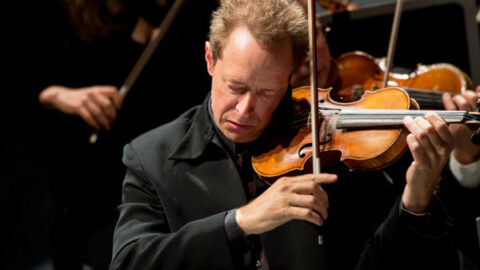 The Berkeley Symphony’s concert on Thursday, February 6 in UC Berekely’s Zellerbach Hall featured the world premiere of Samuel Carl Adams’ Violin Concerto, alongside Stravinsky’s Pulcinella Suite and Mendelssohn’s Scottish Symphony. The program fit together well, and with the works complemented each other. By the time conductor Joana Carneiro took the stage to give her welcome message, the hall was full enough it gave the impression of a sold-out show. Even if the concert wasn’t officially sold out, it is always wonderful to see a full house at a new music concert!
The Berkeley Symphony’s concert on Thursday, February 6 in UC Berekely’s Zellerbach Hall featured the world premiere of Samuel Carl Adams’ Violin Concerto, alongside Stravinsky’s Pulcinella Suite and Mendelssohn’s Scottish Symphony. The program fit together well, and with the works complemented each other. By the time conductor Joana Carneiro took the stage to give her welcome message, the hall was full enough it gave the impression of a sold-out show. Even if the concert wasn’t officially sold out, it is always wonderful to see a full house at a new music concert!

The concert opened with Stravinsky. All of the soloists within the orchestra really shone, especially Cheonho Yoon’s (trumpet) Thomas Horning (trombone) in the Finale. Unfortunately, there were ensemble issues throughout the concert, especially in Pulcinella. Each of the sections played as a unit for the most part, but communication between the sections was practically nonexistent. There were some intonation issues and the balance wasn’t what it should have been, especially when the string soloists were playing. The Tarantella especially was an edge-of-your-seat experience, and not just for the right reasons.
After a brief pause for a minor set change, violinist Anthony Marwood joined the Berkeley Symphony in the world premiere of Samuel Carl Adams’ new Violin Concerto. While the concerto is fantastically difficult for the soloist, the virtuosity wasn’t the point. The piece is more than a “concerto” in the traditional sense. It’s the kind of work that would be hard for a “violinist” to play, but when performed by an excellent musician who happens to play the violin, it really works. Anthony Marwood is such a person, and was able to carry the piece through the woods of virtuosity and present it to the audience.

Adams arranged his concerto into two “acts,” each a pair of movements played without pause. The first act (especially the first movement, expo) was a conversation between the solo violin and the orchestra. The orchestra really pulled it together and presented a solid performance in partnership with Marwood’s violin, effectively representing what Adams’ program notes called a “completely different narrative.” The narrative quality put forth in the first movement continues through the whole work, which is an exploration of anxiety, suspicion, reconsideration, and letting go.
The third movement, aria: patiently waiting for the past to come, was especially poignant. In an achingly beautiful use of texture and form, Adams presents a series of deconstructed fragments of a baroque ritornello form. An effect used before in Adams’s Drift and Providence (commissioned last year by the San Francisco Symphony) was once again employed to great effect: the brakedrums in the percussion section were rubbed rather than struck, creating a grating and ominous texture unique to Adams’ writing. Adams refers to the final movement coda, coda in his notes as “a series of question marks” which eventually fades away leaving only the solo violin’s open strings. It was refreshing to hear a concerto end without the proverbial bang. The quiet ending left the feeling that while the concerto explored themes of uncertainty, Adams was quite sure of the way in which he presented those themes.
The second half of the concert was Mendelssohn’s Scottish Symphony, which went better than the Stravinsky from the first half, although the audience was substantially thinner for the second half, the symphony was well received by those who stayed to listen to it.
























